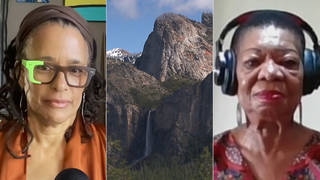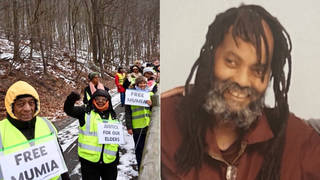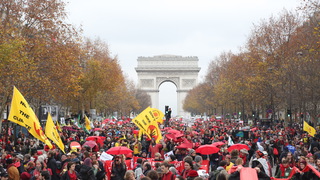
Guests
- Kirk Smithprofessor of global environmental health at the University of California, Berkeley. His most recent article in The Lancet is “The Last Summer Olympics? Climate Change, Health, and Work Outdoors.”
A new article in the medical journal The Lancet has concluded much of the Northern Hemisphere will be too hot by 2085 to host the Summer Olympics. Researchers are projecting only eight cities in the hemisphere outside of Western Europe would be cool enough to host the Games. This includes just three cities in North America: Calgary, Vancouver and San Francisco. The list of cities where it could be too hot is staggering: Istanbul, Madrid, Rome, Paris, Budapest, Tokyo, New York, Chicago, Los Angeles—and the list goes on. Extreme high temperatures have already impacted the athletic world. In 2007, high heat forced the cancellation of the Chicago Marathon. At this year’s U.S. Olympic marathon trials in Los Angeles, 30 percent of the runners dropped out of the race due to the heat. For more, we speak with Kirk Smith, lead author of the article and professor of global environmental health at the University of California, Berkeley.
Transcript
AMY GOODMAN: The 2016 Summer Olympics may have just ended, but might we be seeing the end of the Summer Olympics for good? A new article in the prestigious medical journal The Lancet has concluded much of the Northern Hemisphere will be too hot by 2085 to host the Summer Olympics. Researchers are projecting only eight cities in the hemisphere outside of Western Europe would be cool enough to host the Games. This includes just three cities in North America: Calgary, Vancouver and San Francisco. The list of cities where it could be too hot is staggering: Istanbul, Madrid, Rome, Paris, Budapest, Tokyo, New York, Chicago, Los Angeles—and the list goes on.
Extreme high temperatures have already impacted the athletic world. In 2007, high heat forced the cancellation of the Chicago Marathon. At this year’s U.S. Olympic marathon trials in Los Angeles, 30 percent of the runners dropped out of the race due to the heat. And, of course, this has implications well beyond athletic events.
For more, we’re joined by Kirk Smith, lead author of the article, professor of global environmental health at the University of California, Berkeley.
Welcome to Democracy Now!, Professor Smith. Talk about what you found.
KIRK SMITH: Thank you for inviting me today. Well, I’m sitting in Berkeley, which is part of the San Francisco Bay Area, and we often repeat the—what Mark Twain is often reported to say, which is “The coldest winter I ever spent was a summer in San Francisco.” People who’ve been here know it’s cold in—or it’s cool in the summer. This is going to be an advantage in the future as climate change proceeds, because, as you say, those three cities in North America, including San Francisco—San Francisco is likely to be the last place that a Summer Olympics could be held as they’re held today.
Now, why is that? I mean, what is it that—why does heat make it hard to have the Olympics? Obviously, it doesn’t make any difference for springboard diving, but it does make a difference for outdoor endurance events, like particularly the marathon, but others. And it’s—although temperature is part of the picture, one of the things that people don’t realize as an impact of climate change is that as temperature rises, it increases the evaporation of water from the oceans and other bodies of water, so therefore humidity goes up, as well. And your ability to do outdoor work is a function not only of temperature, but also the humidity. If it’s 100 percent humidity, even a very low temperature will keep—not allow you to work heavily, because you need to sweat in order to give off the extra heat that your body produces when you’re doing work.
So, we took a look at the Olympics in this regard, because we know how they’re run and what kind of, you know, exercise is done. And we took regular climate models that other people are using. We assume the same projection of greenhouse gases that is in the international—the Intergovernmental Panel on Climate Change, the current pattern we’re on. We took both a conservative model and a more liberal model, if you like, and averaged them, so we weren’t—couldn’t be accused of cherry picking. And we were surprised to find how few cities in the world were left in 2085—just eight outside of Western Europe, only three in North America.
So, of course, we’re not really all that concerned about our most elite athletes. They are very well conditioned. They are very well managed by the physicians on their teams. But it’s the tip of the iceberg. The last line in our paper is: “If we have to worry about our most elite athletes, what about the rest of us?” Because it is the rest of us that are most at risk from these rising heat and humidity.
And some, in fact, think it may be one of the—the largest impact of climate change in the next 50 or 60 years will be the change in the ability to do what we’ve always done, doing for 2 million years, is work—work and heavy exertion outdoors. Now, probably very few people listening to this program work all the time outdoors, but 50 percent of the planet does work outdoors all the time, mainly in agriculture and construction. So those professions are more and more challenged, if you like, at certain times of year, as climate change proceeds. The areas of the planet that will be dangerous to conduct that kind of work will grow and grow with climate change. And the Olympics illustrates this. We, of course, published this paper at the time of the Rio Olympics to call attention to the broader problem of climate change changing how we do things.
AMY GOODMAN: You talk about—the report is on the Summer Olympics, your study. What about the Winter Olympics?
KIRK SMITH: Yes. Well, there was a paper also, based on a report done in Canada, that was published in 2014 just before the winter—the Sochi Winter Olympics. And they did a somewhat similar analysis. They took the 19 sites where there had been Winter Olympics before, and examined how many of them would still be viable for the Winter Olympics in about 2085. And they found that only six of them would still be viable. There, of course, it wasn’t the risk to the athletes from exertion and heat; it was whether there’d be enough snow. And so, they used a 30 centimeters of snow, you know, if you—what’s 30 centimeters? You know, 10 inches or 15 inches of snow is the minimum required for the Winter Olympics. And the same issue.
Of course, if—you can get around these things a bit. You can do everything indoors. In fact, more and more, both the Summer and Winter Olympic events have been moved indoors. But it’s a little hard to see how you do downhill skiing indoors. And running the marathon indoors would be a pretty boring event, so—but you can—you could do it. You could do the marathon in January, and—if you like, and that would not be the same Winter Olympics, but there would be ways to adapt your way out of it. The point is that what we’ve been doing for millions of years is no longer possible. We’ve held the Olympics for 2,500 years, you know, a hundred—more than a hundred years in the modern Olympics. And we’ve come to expect certain—you know, certain ways of doing things that are not going to be possible.
And in addition, of course, other people do exertion outdoors for sports. I mean, there are hundreds of marathons every year around the world in cities. And as you mentioned, those are starting to be constricted, as well. The Chicago Marathon had to be stopped in the middle. Hundreds of athletes had gone to the emergency rooms around Chicago because of the temperature and humidity had exceeded the limits for athletes. And, of course, it’s the rest of us are more vulnerable than elite athletes, who are very well trained and finish the—you know, the marathon runners in that marathon finished, the highly competitive ones, in a little over two hours. But, you know, three hours later, there were 10,000 other athletes still out in the heat and humidity. So that’s why they had to stop it. So—
AMY GOODMAN: And, of course, Professor Smith, it’s not only the athletes and then the general population, but the kind of political and social upheaval these—this kind of extreme weather causes.
KIRK SMITH: Well, yes. I mean, I think the—we think the biggest impact will be, as I say, among the poor. I mean, climate change, you know, I’ve said before, is the most—excuse me—the most regressive tax in human history, in the sense that, in general, the rich benefit from the use of fossil fuels and the economy that’s run by them, and the poor get the biggest impacts in terms of—I’m a health scientist, so, in terms of health, it’s the poor that’s going to suffer most from climate change. And an illustration of that is the workers who work outdoors, in this case. I mean, in California, for example, in the Central Valley, we already have a few workers who might die from heat exertion every year in the summer. But that will increase, unless something is done.
Now, what can be done? You can change work practices—allow people to sit in the shade between 10:00 and 2:00 and drink lemonade. But bosses aren’t—well, you know, aren’t known for that kind of laxity. And so, what happens is there gets to be a very difficult trade-off between expectations on productivity, how much you’re supposed to produce, and health. That’s a difficult trade-off. It’s a pernicious trade-off. We want labor to be more productive, of course, but we also want labor to be protected. And it gets more and more difficult.
AMY GOODMAN: Drawing from another sports example, thousands of workers are toiling in extreme heat in Qatar building the stadiums for the 2022 World Cup soccer championships. The International Trade Union Confederation estimates more than 7,000 workers will die before a ball is kicked in the World Cup in 2022.
KIRK SMITH: Yeah, well, that’s a great example, because some people will respond to this, “Well, 2085 is a long way off. By then, we can all be living in air-conditioned malls. We don’t care about the heat outside. We don’t work outside.” But, of course, somebody has to build those malls or those stadiums. Somebody has to repair them. You know, we’re not going to turn into space colonies on the planet Earth. You know, maybe air-conditioned cabs can be developed for farm machinery in rich countries, but they’re not going to be doing that in India in—even in 50 years. So, it’s a set of issues. I mean, the stadium in Qatar will probably be air-conditioned. It’s the only way to protect the people who go to that—who go to those games and the players. But somebody has to build it, and including in the summer.
AMY GOODMAN: Well, Professor Kirk Smith, we want to thank you for being with us. He teaches global environmental health at University of California, Berkeley. And we will link to your study, the recent article in The Lancet, which is headlined “The Last Summer Olympics? Climate Change, Health, and Work Outdoors.”













Media Options